iPhone 15 Pro Max vs Galaxy Z Fold 5: Main differences
We may earn a commission if you make a purchase from the links on this page.

Intro
The iPhone 15 Pro Max is already setting itself as one of the top phones of 2023. With a refreshed titanium design, finally USB Type C instead of Lightning, a new customizable Action Button, a new 5X periscope camera and your usual yearly camera upgrades, the iPhone 15 Pro Max is a slightly more intriguing year-on-year update in comparison with previous iPhone Pro Max launches. This is especially true when you consider that prices haven't gone up, even though the base 128GB version is now MIA.
But we are still talking about a regular candybar phone, while Samsung has a very hot high-profile device in its ranks––the foldable Galaxy Z Fold 5.
Which one is shaping up to be the more intriguing phone of 2023? The more traditional iPhone 15 Pro Max with its superior zooming capabilities, or Samsung's foldable catwalk star that scored some very neat improvements and is overall the best foldable Samsung has made so far?
iPhone 15 Pro Max vs Galaxy Z Fold 5 main differences:
- Standard (iPhone 15 Pro Max) vs foldable form factor (Galaxy Z Fold 5)
- 6.7-inch (iPhone 15 Pro Max) vs 7.6-inch display (Galaxy Z Fold 5)
- 3nm Apple A7 Pro chipset (iPhone 15 Pro Max) vs 4nm Snapdragon 8 Gen 2 for Galaxy (Galaxy Z Fold 5)
- 48MP main (iPhone 15 Pro Max) vs 50MP main camera (Galaxy Z Fold 5)
- 12MP 5X telephoto (iPhone 15 Pro Max) vs 12MP 3X telephoto (Galaxy Z Fold 5)
- 4,422mAh (iPhone 15 Pro Max) vs 4,400mAh (Galaxy Z Fold 5)
- Stylus support (Galaxy Z Fold 5)
- More expensive (Galaxy Z Fold 5)
- 25W wired charging (iPhone 15 Pro Max) vs 45W wired charging (Galaxy Z Fold 5)
Table of Contents:
Read more:
- iPhone 15 Pro Max: news, features, expectations
- Samsung Galaxy Z Fold 5 Review: does evolution stop here?
- Samsung Galaxy Z Fold 6 vs iPhone 15 Pro Max: expectations
Design and Size
Apple's best large iPhone ever versus Samsung’s ambitious foldable
The iPhone 15 Pro Max has scored some serious changes in the design department, giving us a titanium frame that's both lighter and sturdier than Apple's previous stainless steel iterations. Bezels have also shrunk significantly on the iPhone 15 Pro Max, making for a striking, edge-to-edge new design that pushes the boundaries to the maximum. The punch-hole Dynamic Island is now a universal part across the whole iPhone 15 lineup.
Another major change in the iPhone 15 Pro Max's design is the removal of the signature mute switch, or rather, its evolution. The iPhone 15 Pro Max and the iPhone 15 Pro now come with customizable Action Buttons instead of a ringer switch, similarly to the Apple Watch Ultra 2 but thankfully not in orange. This new hardware feature allows you to map different functions and shortcuts for easy access, like quick flashlight toggling, camera access, and so much more. Of course, switching between silent and ring modes is also possible.
Oh, and how did we miss the big news about the proverbial death of the decade-old Lightning cable? Yes, USB Type-C has now come to the iPhone, and the iPhone 15 Pro Max has the exclusive potential support of USB 3.0, which theoretically allows data throughput speeds of up to 10Gb/s with a compatible cable. Sadly, the adoption of USB hasn't drastically increased charging speeds, but we'll take whatever wins we can.
What about the Galaxy Z Fold 5? There are some important changes. While the folding book and general appearance of the Galaxy Z Fold 5 is the same, Samsung has improved the hinge mechanism in such a way that there’s no longer a tiny gap between the left and right panels of the phone when you fold it. With the Galaxy Z Fold 5, these are now completely flush and parallel to one another, rectifying one of the persistent major issues with the Galaxy Z Fold range.
Naturally, being a foldable, in its folded state the Galaxy Z Fold 5 is a larger and thicker device than the iPhone 15 Pro Max. Samsung’s latest phone stands at 67.1 x 154.9 x 13.4mm, but once you unfold it, it measures up at 129.9x 154.9 x 6.1mm. The phone weighs in at 253gr, which is lighter than its predecessor, but noticeably more than the iPhone 15 Pro Max's 221gr weight brought down by the titanium frame.
The display crease is still there, but what can you do.
If you've been saving money for the new burgundy red shade of the iPhone 15 Pro Max, then tough luck: Apple unveiled four new metallic shades for the iPhone 15 Pro Max: Natural Titanium, Black Titanium, White Titanium, and Blue Titanium. All of them look classy and have that premium-looking brushed titanium finish. The backplate is matte black, in a typical iPhone Pro Max fashion.
With IPX8 water protection, the Galaxy Z Fold 5 can survive for up to 30 minutes in 1.5m of freshwater, but you’d be better off keeping it away from salt water as well as pools. Meanwhile, the iPhone 15 Pro Max enjoys the usual IP68 water- and dust-resistance.
The Galaxy Z Fold 5 comes in Icy Blue, Phantom Black, and Cream colors, while the Gray and Blue variants are exclusively available for those that purchase the phone from Samsung.com.
Display Differences

Apple hasn't changed the formula behind the iPhone 15 Pro Max. We have gotten the good ol' 6.7-inch Super Retina XDR OLED display with HDR support and 120Hz ProMotion that makes everything look oh-so-smooth and scrolling quite rewarding. The maximum display brightness hasn't been improved, either, but it's already high enough for just about anyone's regular needs.
The specs behind the Galaxy Z Fold 5's internal and external displays aren't changed as well. The external Dynamic AMOLED 2X screen remains a 6.2-inch one with 48-120Hz smooth refresh rate and and will most certainly retain its excellent color rendition.
The same applies to the larger-than-life internal display, which has a square-ish aspect ratio of 21.6:18 and spans 7.6 inches across. This one is even smoother than before, with a 1-120Hz refresh rate screen that dynamically switches depending on the viewed content. And yes, as we mentioned, there's a display crease, which is in the middle of the screen, but getting used to that one isn't that hard.
Just like the Z Fold 4, the Galaxy Z Fold 5 features a side-positioned fingerprint scanner, which should be fast and reliable based on our previous experience with Samsung fingerprint sensors. There’s also 2D picture-based Face Unlock that’s probably not that secure.
Meanwhile, the iPhone 15 Pro Max relies on a sole biometric unlocking method––Face ID. It’s rather secure thanks to its 3D mapping of the user's facial features, and also quite intuitive, as it requires just a simple glance.
Performance and Software
Checkmate with the 3nm chip!
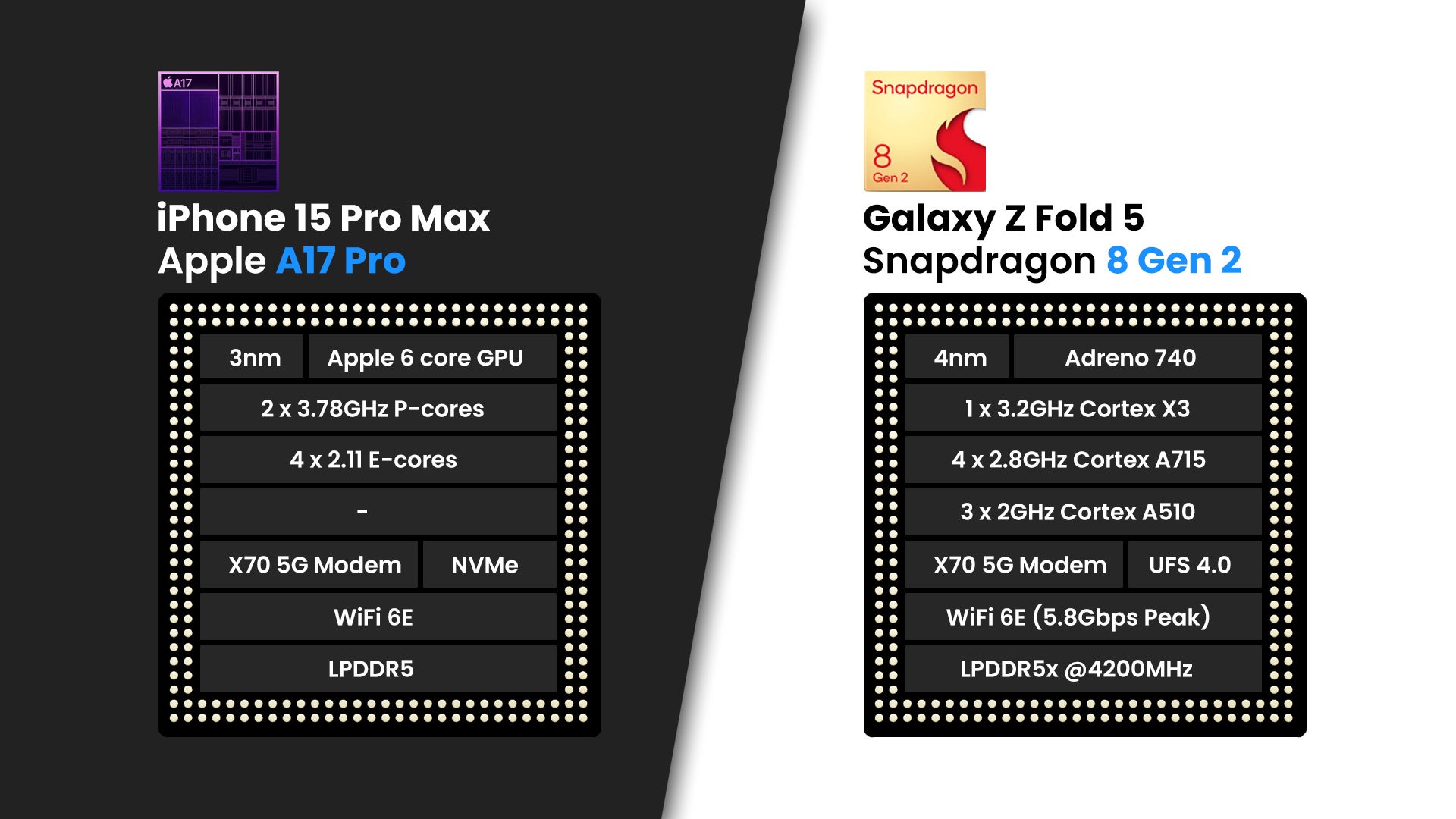
The iPhone 15 Pro Max comes along with a 3nm chipset, the Apple A17 Pro, which introduces slightly improved performance in comparison with Apple's previous Pro-grade chips, the A16 Bionic chip.
The move down to the super-dense 3nm manufacturing process has allowed Apple to stuff a couple billion extra transistors, which deliver roughly 10% better performance than the already super-speedy A16 Bionic. However, despite our wishful expectations, Apple doesn't hint at the A17 Pro being way more efficient than before, as both the iPhone 15 Pro Max and the iPhone 15 Pro have the same official battery life expectations.
What's more, the faster A17 Pro is seemingly overtaking the iPhone's cooling capabilities, which leads to numerous reports about serious overheating in some situations.
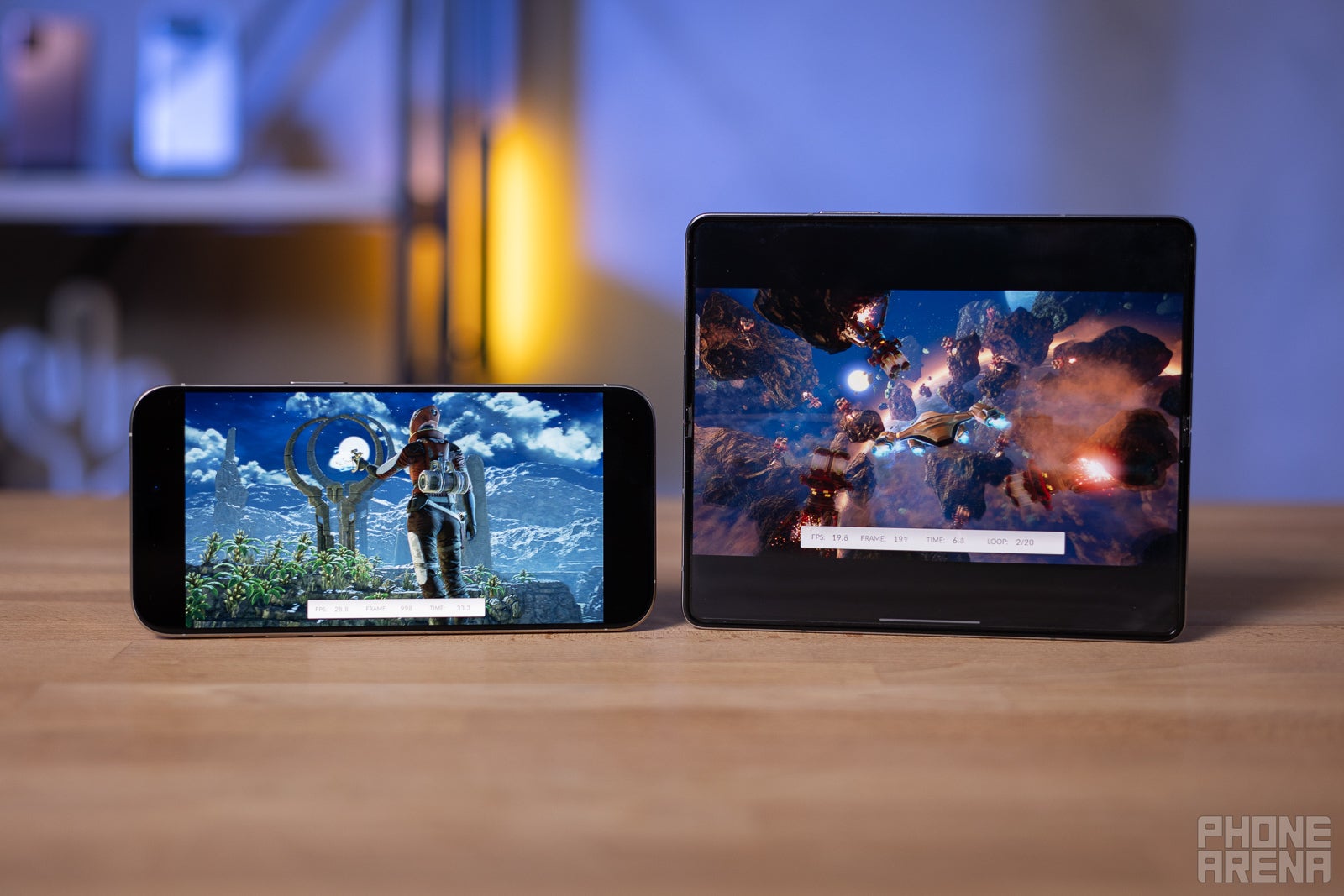
One area in which the iPhone 15 Pro Max dominates are graphics. The A17 Pro now features a 6-core GPU and also supports hardware ray-tracing, which only spells good things for gamers.
Meanwhile, the Galaxy Z Fold 5 comes with the Qualcomm Snapdragon 8 Gen 2 for Galaxy chip, which is a superb silicon with extremely good performance and efficiency. We’ve already seen it run things with the Galaxy S23 series, so it’s safe to assume top-tier performance and efficiency on the Galaxy Z Fold 5 as well.
In terms of storage, the iPhone 15 Pro Max is available in 256GB, 512GB, and 1TB of storage. Meanwhile, the Z Fold 5 comes along with 256GB, 512GB, and 1TB storage versions, with no option to extend that via a microSD card.
The more important differences, however, will be in the software department, where we have the latest and greatest iterations of iOS and Android. The iPhone 15 Pro Max will come with iOS 17 out of the box, while the Z Fold 5 employs the services of Android 13 with the latest One UI 5.1.1 on top. Both phones should receive long software support: the iPhone 15 Pro Max to at least 2028, while the Z Fold 5 will be getting four major Android software updates and will get security updates until 2028 as well.
With the Z Fold 4, we got a desktop-like app dock, and the Galaxy Z Fold 5 expands on that with a new dock that now shows your most recent apps you’ve used, allowing you even faster switching between those. There’s your usual DeX support, which lets you hook the phone to an external display and periphery and use it as a portable mini PC of sorts, as well as so much more.
That said, the Android-powered foldable phone has way more going for it to be a proper productivity tool. Aside from the large internal display, which is perfectly suited for multitasking, Samsung has graced the foldable with its usual trove of software features and functionalities to improve its overall utility.
You can also get an S Pen and a case to tuck away the stylus for that extra productivity boost.
Apple released the significant iOS 17.1 software update, which includes a number of improvements, around the end of October 2023. StandBy, the new feature that displays information while the phone is charging, has been much improved. The Apple Music user experience has also been improved in a number of ways.
Additionally, iOS 17.1 supports AirDrop over cellular connections, allowing you to send large files even when two iPhones are not in close proximity. Other improvements and bug fixes are included in the iOS 17.1 software release. According to many users, the iPhone 15 series still has persistent bugs, such as keyboard lag and a Wi-Fi issue that affects many new iPhone 15 units.
Camera
Big strides for Apple
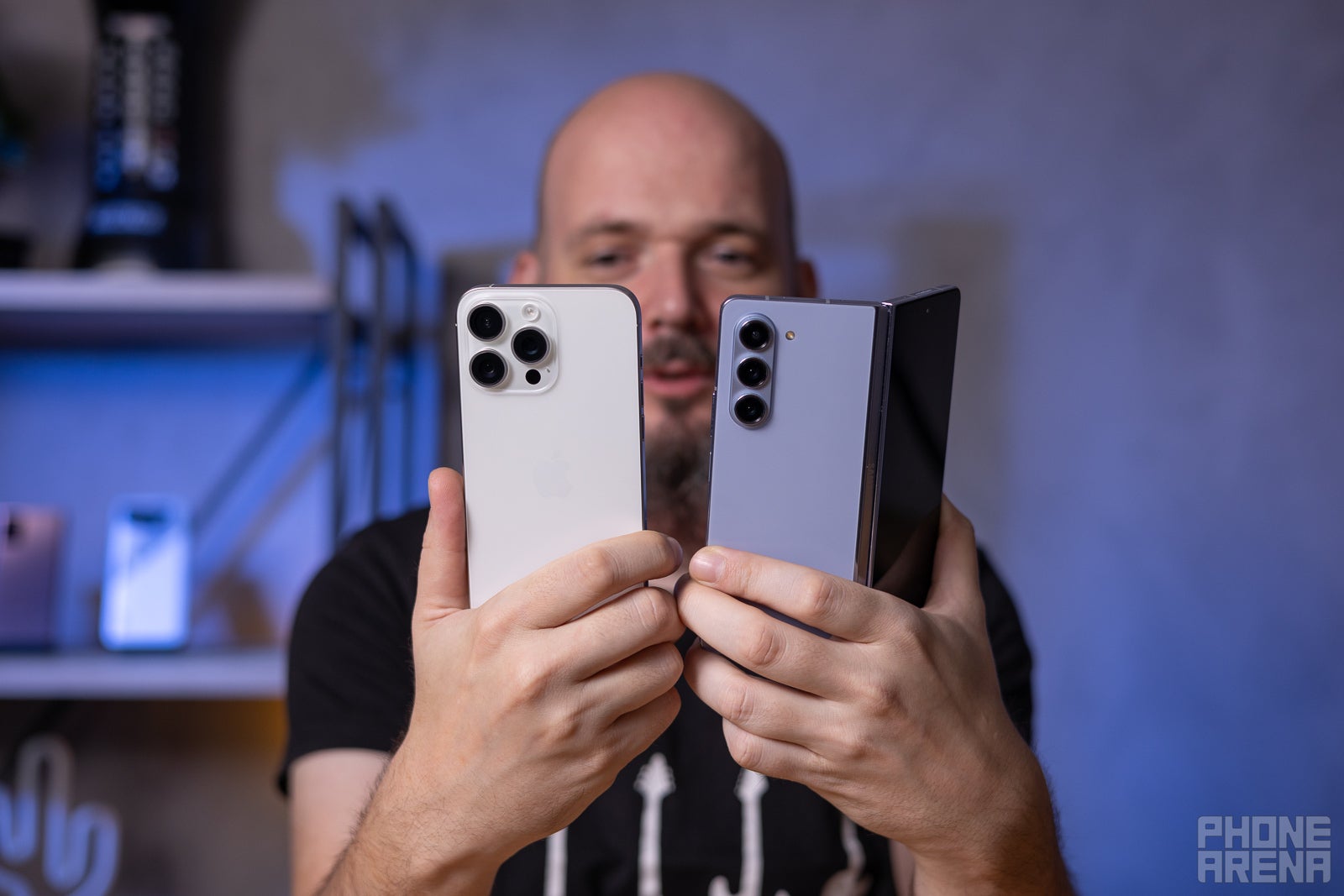
The iPhone 15 Pro Max has scored an even more capable 48MP camera, which shoots 24MP photos by default and also allows you to fine-tune the perceived focal length of the wide-angle camera. Yes, you can choose if the main camera should take 24mm, 28mm, or 35mm photos. With a new version of the Photonic Engine and Smart HDR, Apple teases the most capable iPhone camera ever.
Most intriguing, however, is the new 5X periscope telephoto lens on the iPhone 15 Pro Max, which employs a tetraprism mechanism and bounces light around in order to achieve a 120mm focal length equivalent. Technically, it's not a periscope as it doesn't refract light at 90 degrees. This camera is shorter than what the Galaxy S23 Ultra is capable of, for example, but longer than the Galaxy Z Fold 5's 3X telephoto.
Portraiture has also been improved: taking regular photos will simultaneously capture depth data, allowing you to turn a photo into a portrait later on.
At the same time, the Galaxy Z Fold 5 doesn’t bring anything new and exciting to the table, especially in terms of hardware. The camera setup is mostly similar to what we saw with the Galaxy Z Fold 4, but that’s mostly okay, as it’s still a very capable setup that. What’s more, the Galaxy Fold line was never about camera prowess, so we probably should never expect crazy long zooms or large sensors to make the cut.
In essence, with the Galaxy Z Fold 5, we get a 50MP wide-angle main camera with Dual Pixel autofocus, OIS, and F1.8 aperture. Joining forces is a 12MP ultra-wide with an F2.2 aperture and 12-degree field-of-view, as well as a 10MP telephoto that boasts 3X optical zoom and has an F2.4 aperture and OIS for jitter-free zoomed photos.
There are two selfie cameras on board. There’s a 10MP punch hole on the external screen and a 4MP under-display camera on the internal display. It goes away when not in use, and while you can definitely see where it’s supposed to be, suspending your disbelief easily makes it almost invisible in most cases.
Main camera
The iPhone goes for a more realistic and grounded-in-reality color and dynamics, while the Galaxy Z Fold 5 employs too oversaturated colors. The same is not only true about skies, which appear unnaturally and outworldly vivid on the Galaxy Z Fold 5, but also with skin tones.
In near pitch darkness, both devices automatically take long-exposure shots, with the iPhone 15 Pro Max captures more detail.
Ultra-wide
Zoom quality
At 3X, the Galaxy Z Fold 5's telephoto lens kicks in, providing excellent detail though some noise can be exhibited when you zoom in. The same is true for the iPhone, but to a slightly greater extent. However, at 5X, the new tetraprism-enabled camera kicks in and the iPhone 15 Pro Max dominates the Galaxy Z Fold 5, which solely relies on digital zoom.
Selfies
The iPhone delivers much better detail, realistic colors, and dynamics, making for a superb selfie. The Galaxy Z Fold 5 does an okay job with its external camera, but the inner 4MP under-display selfie snapper is, as usual, disappointing to say the least.
Audio Quality and Haptics
Both the iPhone 15 Pro Max and the Galaxy Z Fold 5 come with stereo speakers. While we haven't heard the iPhone 15 Pro Max's speakers in real life, chances are that they will be among the better-sounding ones on a phone.
As far as haptics are considered, we expect that… both phones will have vibrator motors on board! Lame jokes aside, excellent and pleasing haptic feedback on both flagship phones.
Battery Life and Charging
Woe to the vanquished

The iPhone 15 Pro Max comes along with a 4,422mAh battery, which is an among the largest ever fitted on an iPhone and helps the iPhone get the upper hand in terms of . What about the Galaxy Z Fold 5? Well, it has a 4,400mAh battery on board, which delivers decent battery life thanks to the power efficiency of the Snapdragon 8 Gen 2. You get a full day's worth of battery life with the Galaxy Z Fold 5, but your mileage will definitely vary depending on which screen you use more.
On the topic of charging, the iPhone 15 Pro Max's outfitted with 25W wired charging solution, just like its predecessor. That's in stark contrast with the rumors that called for faster 35W charging on the iPhone 15 Pro Max. MagSafe wireless charging is still on board.
Meanwhile, the Galaxy Z Fold 5 supports up to 25W wired charging, so it technically has the upper hand here. A full charge takes 80 minutes, but a quick 30-minute charging session gets you more than half a tank of battery life. MagSafe and Fast Wireless Charging 2.0, both capped at 15W, make the rounds on the iPhone and the Galaxy, respectively.
Specs Comparison
Compare the iPhone 15 Pro Max vs Galaxy Z Fold 5 specs here. For your convenience, we've summed up the essential differences between the two juggernauts:
| iPhone 15 Pro Max | Galaxy Z Fold 5 | |
|---|---|---|
| Size, weight | 159.9 x 76.7 x 8.25 mm Weight: 221gr | Folded: 67.1 x 154.9 x 13.4mm Unfolded: 129.9x 154.9 x 6.1mm Weight: 253gr |
| Screen | 6.7" OLED 120Hz ProMotion | External: 6.2" Dynamic AMOLED 2X 48-120Hz Internal: 7.6" Dynamic AMOLED 1-120Hz |
| Processor | A17 Pro 3nm | Qualcomm Snapdragon 8 Gen 2 4nm |
| RAM, Storage | 8GB/256GB 8GB/512GB 8GB/1TB | 12/256GB 12/512GB 12/1TB LPDDR5X UFS4.0 |
| Cameras | 48MP main 12MP ultra 12MP 6X periscope zoom 12MP front | 50MP F1.8 main 12MP F2.2 ultra-wide 10MP F2.4 3X telephoto 10MP external front 4MP internal under-display camera |
| Battery | 4,422mAh | 4,400 mAh |
| Charging | USB-C 20W wired MagSafe | USB-C 25W wired (up to 50% in 30min) Fast Wireless Charging 2.0 |
Summary and Final Verdict
So, albeit quite different from one another, both the iPhone 15 Pro Max and the Galaxy Z Fold 5 will probably be vying for your attention, provided that you're in the market for a super-premium phone this fall.
This means that you can get an iPhone 15 Pro Max starting at $1,199 for the 256GB, $1,399 for the 512GB, and $1,599 for the 1TB version. Meanwhile, the Galaxy Z Fold 5 remains one of the most expensive Samsung devices on sale, but the price hasn’t surged up. It starts at $1799.99 for the 256GB entry-level version, goes to $1919.99 for the 512GB one, and culminates with the 1TB version which goes for $2,159.99. A premium price for a premium phone.
Despite the ongoing rumors about a potential price hike, Apple kept the iPhone 15 Pro Max largely unchanged. Yes, the entry-level 128GB tier was canned, but it's all good, as the pricing of the rest of the variants was kept on the same levels as the iPhone 14 Pro Max.
Despite the polar-opposite ecosystems, these two phones definitely can be considered by just about anyone. The iPhone 15 Pro Max will be the traditional candybar offering that Apple will puts all of its faith into, with revised design and improved hardware. Meanwhile, riding the wave of innovation and novelty, the Galaxy Z Fold 5 is absolutely the more interesting device.
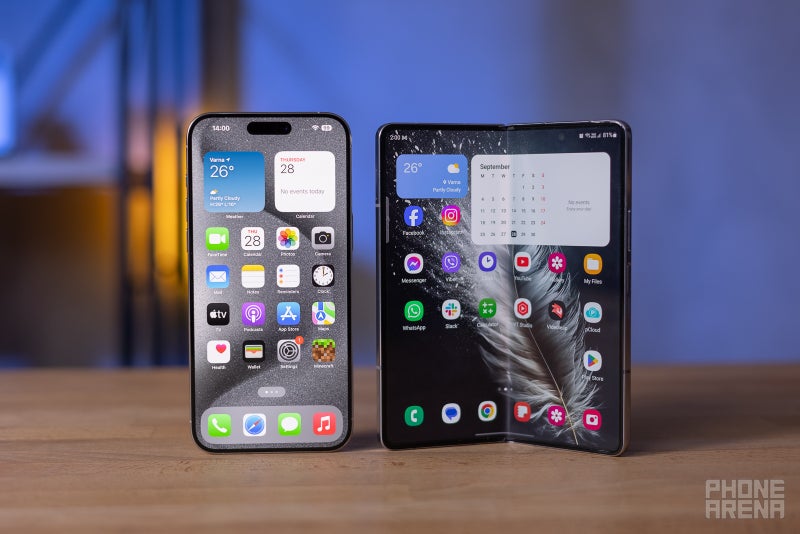
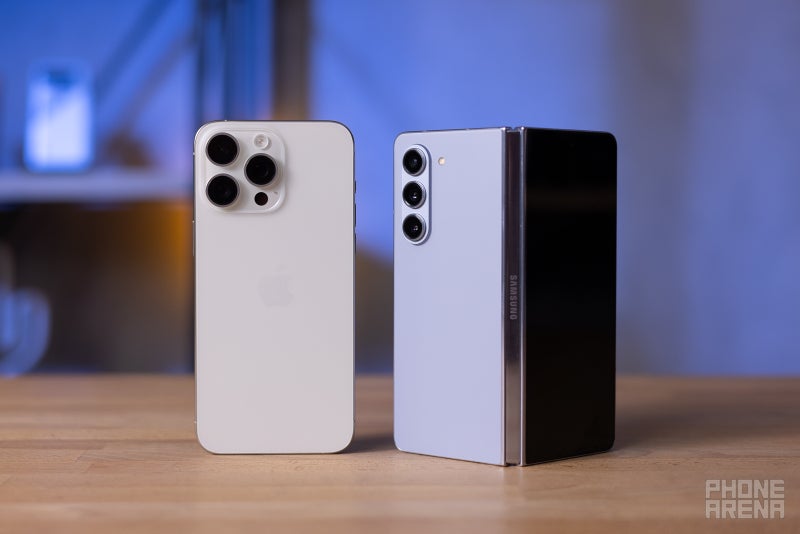
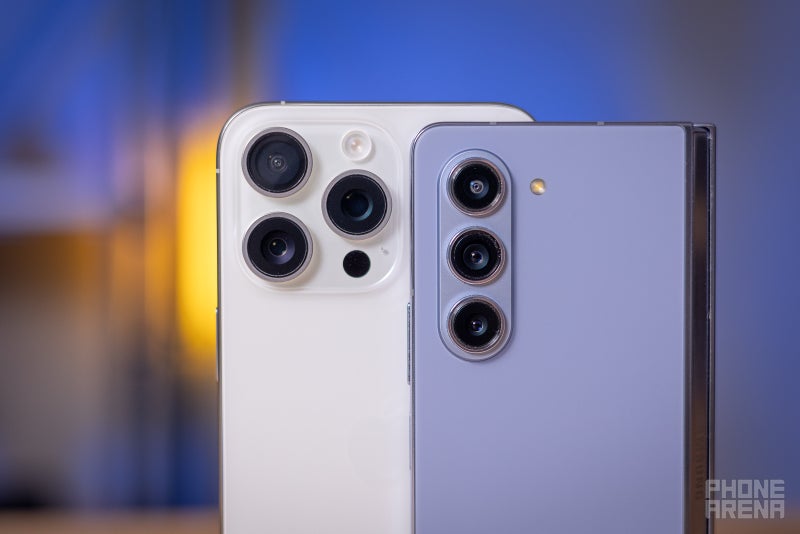
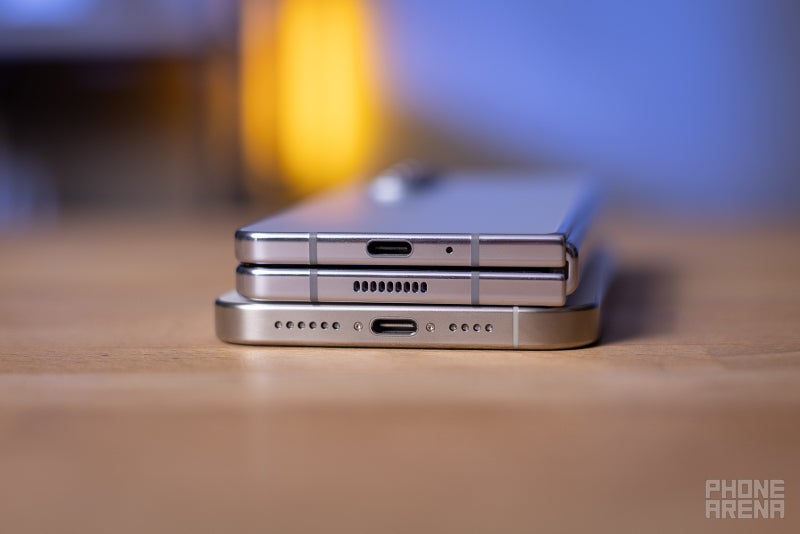
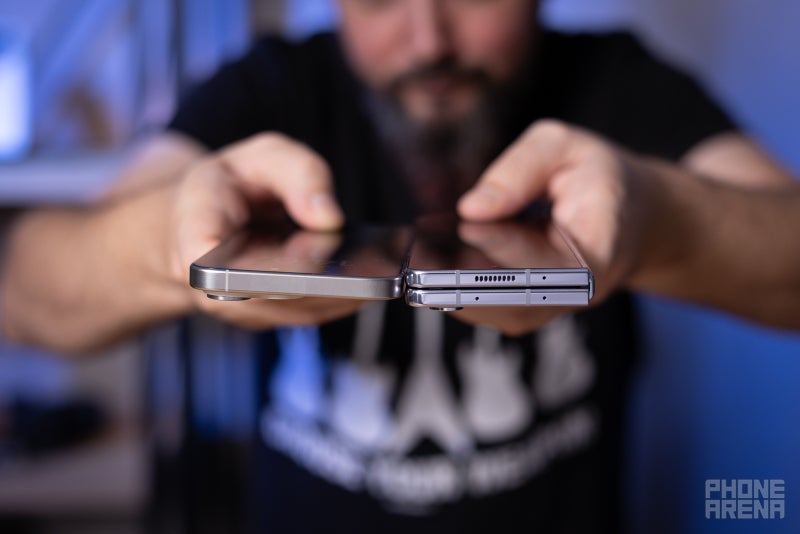
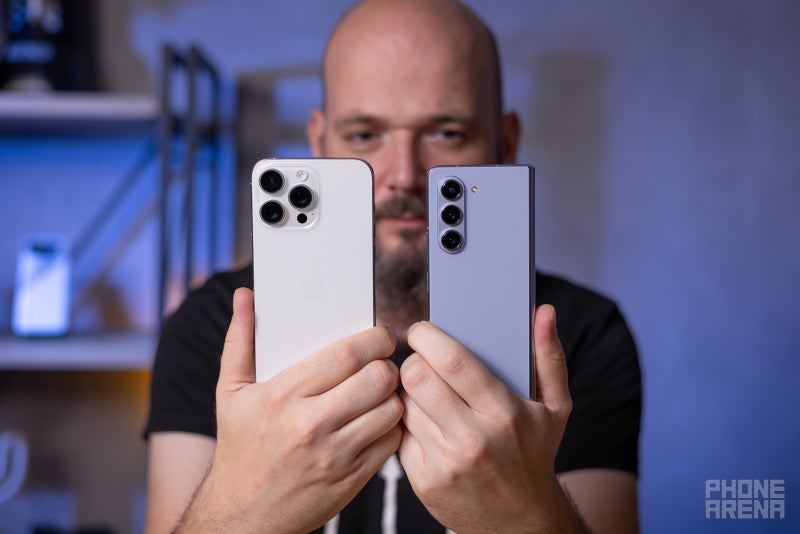








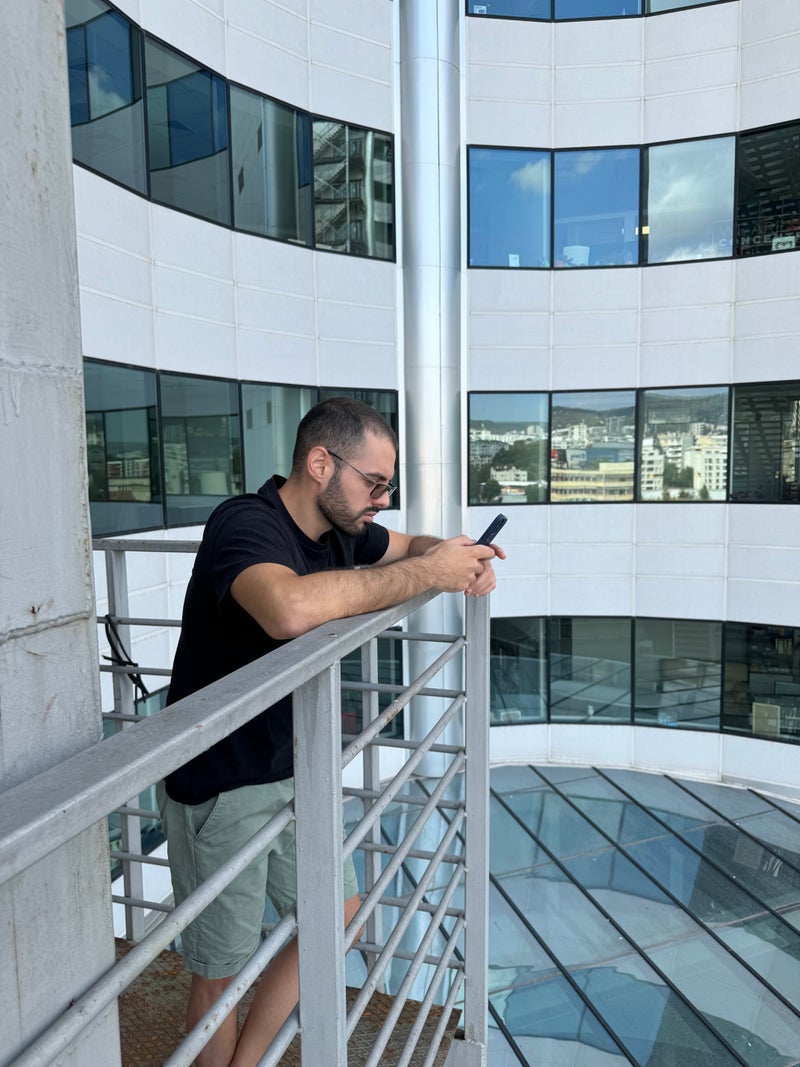
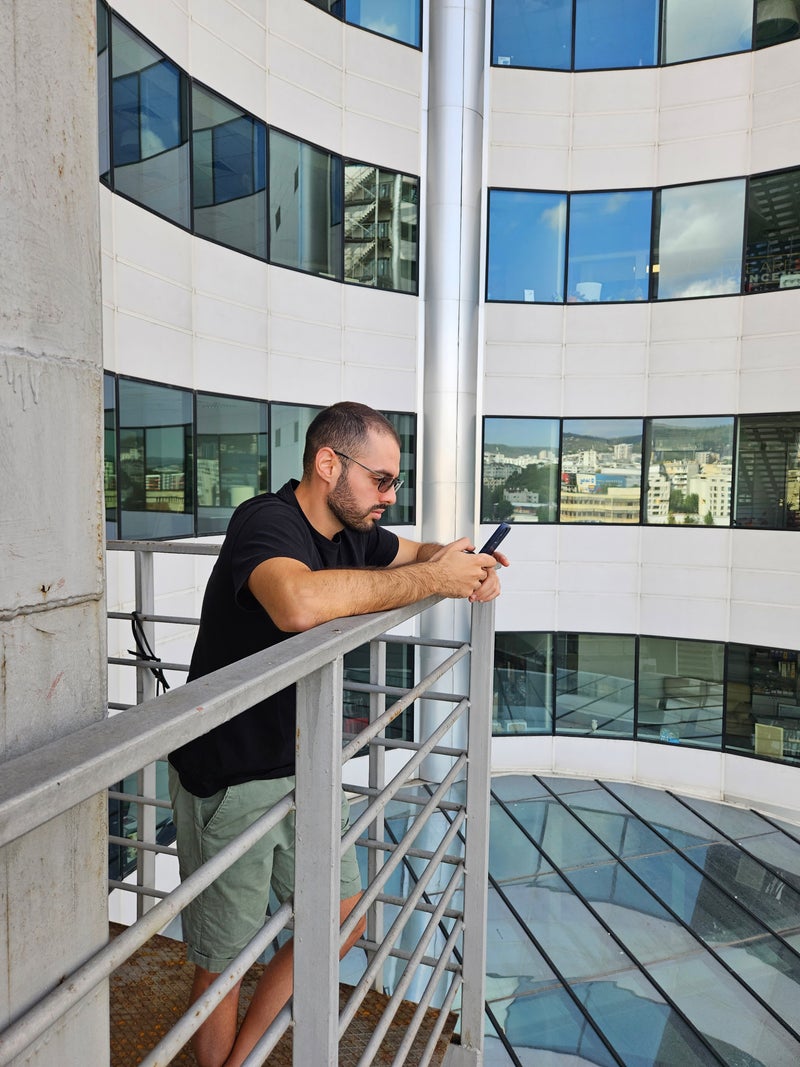
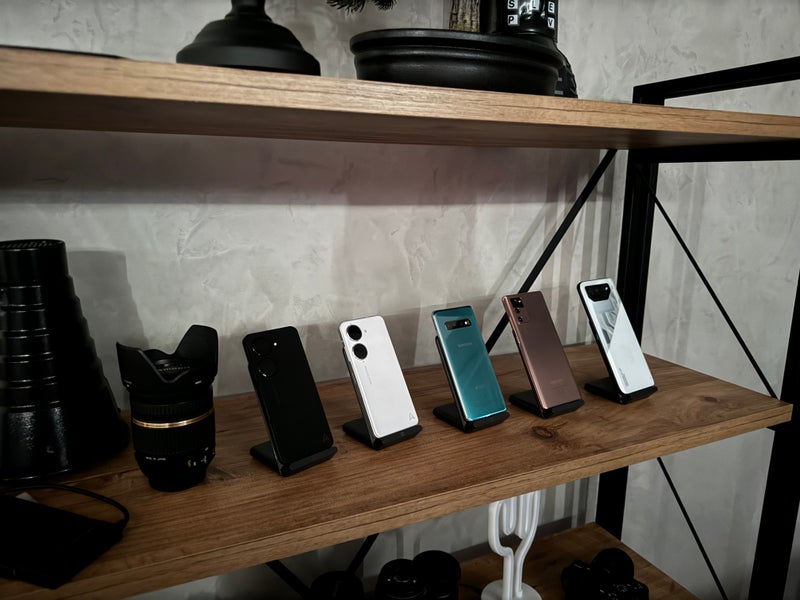
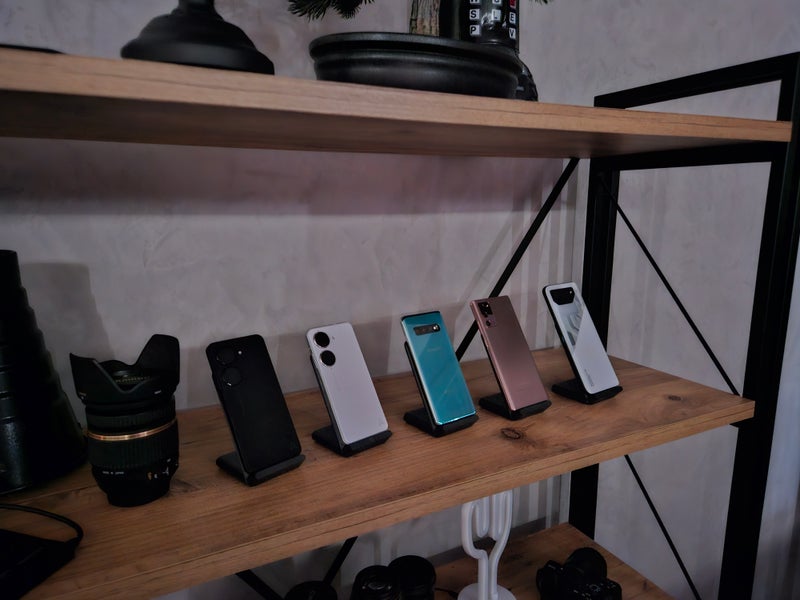




























Things that are NOT allowed: